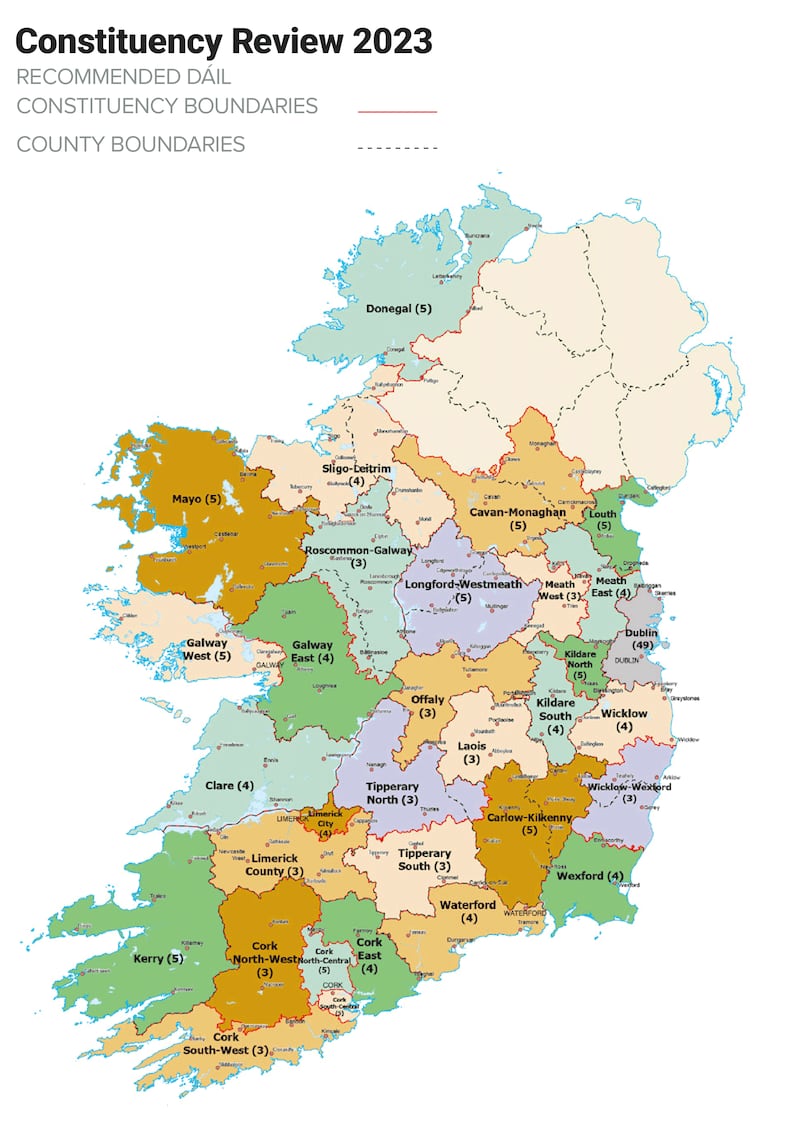“We’re not crying.”
“It could have been worse.”
“Look, it’s more seats, so everyone’s okay with it.”
The reactions from across the political spectrum to the publication of the Electoral Commission’s recommended boundary revisions were relatively muted, as the prospect of 14 more seats to fight for softened the worries of the parties.
‘You’re breaking up a town’: Electoral map changes split Tallaght and could leave Fettercairn ‘forgotten’
Sitting TDs assess re-election chances after losing key areas in constituency review
What is the optimal number of TDs for Ireland? There’s a formula for that
Battlelines drawn up as new election map sends political parties into planning mode
On balance the larger parties were happier than the smaller ones. The Greens were not helped much, nor was Labour or the Social Democrats – but the smaller parties were always going to be faced with pressure on their seats from Sinn Féin. The addition of four more three-seaters and only two more five-seaters was a sign of the direction of traffic; it’s a lot more difficult for smaller parties to win seats in three-seaters.
Sinn Féin can target substantial gains in the next election, though that is more down to the fact of that party’s increased support – and the fact it left several seats behind last time by not running enough candidates – than any major moves by the Electoral Commission. It will target gains in Dublin Mid-West, Waterford, Dublin Central and South-West, in Cork North and South Central and lots of other places – but all these it would have targeted anyway.
Fine Gael and Fianna Fáil will have their local dilemmas over candidates. But the picture for them is not materially better or worse as a result of yesterday. The extra seats will be a cushion, especially in places like Mayo, Galway East, the two Fingals and the two Tipps, and in Longford-Westmeath.
The new Dáil will have a new magic number: 88. The body will grow from 160 TDs to 174; half of that plus one is 88. So that’s the number of seats that a party – or more realistically, a coalition of parties – must assemble if they are to form a government.
[ Electoral boundaries review: How did your constituency fare?Opens in new window ]
The first rule of politics, the former British chancellor of the exchequer George Osborne was fond of saying, is that you have to be able to count. Well, 88 is the number that matters now.
Over the coming days and weeks, TDs, their parties and potential candidates will pore over the boundary changes and constituency redraws to judge where the votes are, where they’re going and who it suits. Plenty of time for that. Their deliberations will impact directly on the candidate strategy adopted.
The headline findings are plentiful: more TDs, elected in more constituencies (up from 39 to 43), more of which – controversially – will return three TDs. The commission acknowledged the general desire among submissions to it was for more five-seat constituencies and fewer three-seaters.
Commission official Tim Carey told Wednesday morning’s media briefing that the increase in three-seaters was “inevitable . . . but not as many as there could have been”.

Officials said afterwards that going to 178 seats would have meant an additional eight three-seaters, with the total number of constituencies rising to 51. That would have been a complete redraw of the electoral map of the country.
Instead, the commission has sought to maintain the existing shape of the constituency map. There are four more constituencies, formed by the division of existing five-seaters and the creation of a new inter-county constituency of Wexford-Wicklow, comprising the northern end of Wexford and southern parts of Wicklow.
[ Constituency review: ‘Wicklow-Wexford’ fails to excite shoppersOpens in new window ]
[ Foxrock surprised yet sanguine about moving to Dublin Rathdown constituencyOpens in new window ]
There are two fewer four-seaters (15, down from 17) and two more five-seaters, with additional seats for Mayo and Dublin Mid-West, Cork North Central and South Central, Dublin West, Longford-Westmeath and Kildare. The old five-seaters of Fingal, Tipperary, Laois-Offaly, Wexford and Wicklow are gone, down a seat or divided, but a few big rural constituencies remain – Donegal, Kerry, Cavan-Monaghan and the urban-rural mix of Galway West.
[ Constituency review: Who are the winners and losers?Opens in new window ]
Swings and roundabouts, so. The changes are probably as limited as they could have been – a fact facilitated by the commission’s decision to increase the permissible variance from the national average.
Each TD represents just under 30,000 people – but some represent more and some less, depending on the constituency. The variance from this number, up or down, has increased from 5 per cent in the last revisions to 8 per cent today.
If this is less satisfactory from a democratic or equality perspective, it is the price of a much more disruptive redraw of the boundaries.














